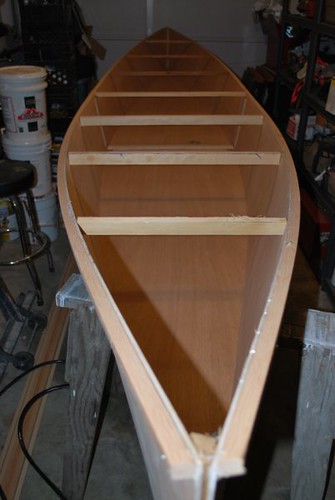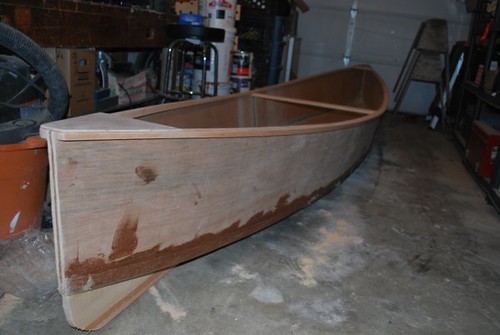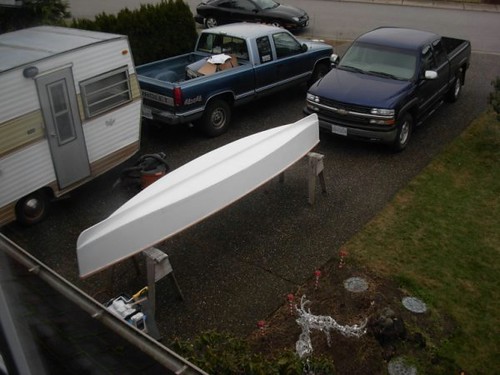
How Rick built a boat in 4.5 hours + three sheets exterior ply
Rick Landreville is a Canadian and the fastest boatbuilder I know. He is an absurdly fast boatbuilder. He prototyped the Quick Canoe plan for me.
Rick’s fast building tips are really worthwhile for the rest of us …
He was using the detailed plan for the Quick Canoe 155 prototype.
A professional video of how to build the Quick Canoe
Trying new methods for simpler plywood canoe building
Some new building methods were used – at least to Rick and me. In particular using duct tape to hold the boat together rather than stitching or cable ties.

We all know about Stack Cutting ply.
I cut the third plywood sheet in half, then stacked the four sheets together and cut out all the sides at once.

Then separated the two upper sheets and cut out the bottoms at the same time. Pretty quick and easy this way. I think the pictures explain a lot.
Here are some pics. I spent 45 minutes laying it out, then had to go inside for Christmas festivities, then spent 20 minutes cutting out the parts, then had to go in again, then spent 20 minutes belt sanding all the parts and gluing in the butt straps on.
Rick.
Rick used a belt sander. to trim the sheets down to the line.
Good job shown here.
A belt sander will be quite risky for most people to use .. I recommend a plane. Rick got the belt sander for Xmas I think.

The next stage was to do the duct taping and control the width of the boat at the sheerline. Rick was a bit impatient with this and tried to fly through it rather than the methodical, more plodding method from the designer. He ended up having some trouble with the boat being too floppy. He took it apart and then followed the duct taping directions in the plan – and it worked.
This photo below is an Australian build by Cliff and PJ over a week for a boat festival the following weekend.
But it shows the beginning of the taping. and using masking tape to reduce mess.

The plans are Set up for epoxy or Alternative glues.
Epoxy for Longevity. PL-Premium (Rick has used others and found them less durable) for cheapness with less Longevity.
He was pretty happy if a bit unwell.
I have been sick with a sinus infection and a fever for the last 3 days, and have been flat on my back in bed. Today was an improvement, so I worked for about an hour and got it 3D.
Rick.

It is understood that many people might choose to go cheap with this boat, so while epoxy is preferred there is information about using the cheaper polyester resin – it doesn’t stick to wood as well so the boat will be less durable – but cheaper. Or using wood in the corners along with either epoxy or one of the alternative glues. Rick recommends PL Premium.
Perttu builds his canoe in Finnish snows and then takes it on a river trip – videos!

The reason it works is that the plywood side panels are spaced the right distance apart before the bottom is put on. Here you can see the spacers that were in place.
The Big Time Saver for glassing or epoxy filleting the seams – long clean join with no stitching makes it efficient
The reason it reduced build time is as opposed to stitching with copper wire or cable ties there are no bumps on the inside of the boat to work around. The interior is completely clear for either epoxy filleting or glass taping with 50mm (2″) wide tape.

Painting – go simple or complicated?
Okay, I finished the plywood canoe today. (well, everything except painting it). I have a total of 4 hours and 25 minutes of build time, and anticipate another 4-5 hours to sand, prep and paint it.
But this is the dilemma; Do I just prime it and give it one finish coat, and not sand anything at all (keeping in tune with the ‘quick and dirty’ build)? Or do I spend a couple of days on it and varnish it up to a yacht finish? I tend to use my boats hard, and often. A yacht finish looks as crappy as a second rate job after a month or so…
Rick.

A couple of days later there was a break in the Canadian Winter and Rick and his girls tried it out on the local pond.



Rick got it out on some open water a couple of week later. He thought it tracked nicely for a travelling canoe. Still looks very cold to me!

The boat came out pretty lightweight at about 48lbs built of standard building trade materials.
The stability (not to mention floor space) will make it very suitable as a fishing canoe as well.
Plans are available from Duckworks for $40 from my agents. Duckworks has a good information piece up here plus the ordering info.
Several Canoes? Then you need a triple storage rack to build yourself
This is a Slideshow building the Quick Canoe in 4 1/2 hours – more links below that.

More Quick Canoes
The full story on the design and building of the first boat is here Quick Canoe General Information is here
Buy Plans For Quick Canoe